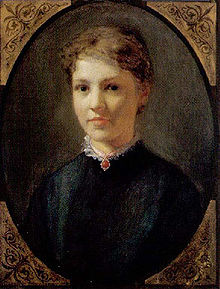Eduard bitterly
Eduard Bitterlich (born August 17, 1833 in Dubljany ( Galicia, today Ukraine ), † May 20, 1872 in Pfalzau (municipality of Pressbaum ), Lower Austria ) was an Austrian painter and sculptor .
Life
Bitterlich attended the Schottengymnasium in Vienna and was trained as a draftsman and miniature painter at the Vienna Academy by Ferdinand Georg Waldmüller . In 1855 he went to Venice to copy the masterpieces from the museums and churches there for a Venice illustrated book for Österreichischer Lloyd .
After his return, Bitterlich entered Carl Rahl's studio. Together with him and another student of Rahl, Christian Griepenkerl , he frescoed the staircase of the Imperial and Royal Army Museum (today: Museum of the History of the Army ) with allegorical figures. Subsequently, he continued to work with Rahl for many years at the Vienna Court Opera and, after Rahl's death, completed his designs with Christian Griepenkerl. The stage curtain and the frescoes in the auditorium of the opera were destroyed in 1945 in several air raids .
Bitterlich mainly worked as a history painter and was the founder of idealistic painting in Vienna, which developed fully as monumental painting in the service of decorating buildings . He also became a member of the Imperial and Royal Academy of Fine Arts .
Bitterlich was next to Griepenkerl and August Eisenmenger, the most talented and successful student and assistant Rahl. From his independent work are worth mentioning: the Pompeian representations in the palace of the Ypsilantis family , the frescoes in the dining room of the Vienna Grand Hotel , pictures for Hernstein Palace , the work of the arts for a palace by the architect Carl Tietz , frescoes in the Heinrichshof and in the Palais Gutmann as well The Three Graces in Watercolor (1871), known for the chromolithographic reproduction of the Society for Reproductive Art Vienna . Much of his work was created in collaboration with the architect Theophil von Hansen .
The father of the sculptor Hans Bitterlich was bitter . He was buried in a grave of honor at the Vienna Central Cemetery. In 1929 Bitterlichstrasse in Vienna- Favoriten was named after him and his son Hans.
literature
- Werner Kitlitschka : The painting of the Vienna Ringstrasse. Verlag Steiner, Wiesbaden 1981, ISBN 3-515-02484-0 .
Web links
- Entry on Eduard Bitterlich in the Austria Forum (in the AEIOU Austria Lexicon )
- Entry on Eduard Bitterlich in the database of the state's memory of the history of Lower Austria ( Museum Niederösterreich )
- Anna Hottner-Grefe : bitterly father and bitterly son. On the hundredth anniversary of the great sculptor's birthday .. In: Neues Wiener Journal , January 15, 1934, p. 4 (online at ANNO ).
Individual evidence
- ↑ a b bitterly Eduard. In: Austrian Biographical Lexicon 1815–1950 (ÖBL). Volume 1, Verlag der Österreichischen Akademie der Wissenschaften, Vienna 1957, p. 88.
- ^ Karl Ginhart: Viennese art history. Verlag Neff, Vienna 1948, p. 242.
- ^ Meyers Konversationslexikon 1885-1892
| personal data | |
|---|---|
| SURNAME | Bitter, Eduard |
| BRIEF DESCRIPTION | Austrian painter and sculptor |
| DATE OF BIRTH | 17th August 1833 |
| PLACE OF BIRTH | Dubljany , Galicia today Ukraine |
| DATE OF DEATH | May 20, 1872 |
| Place of death | Pfalzau, Pressbaum |
